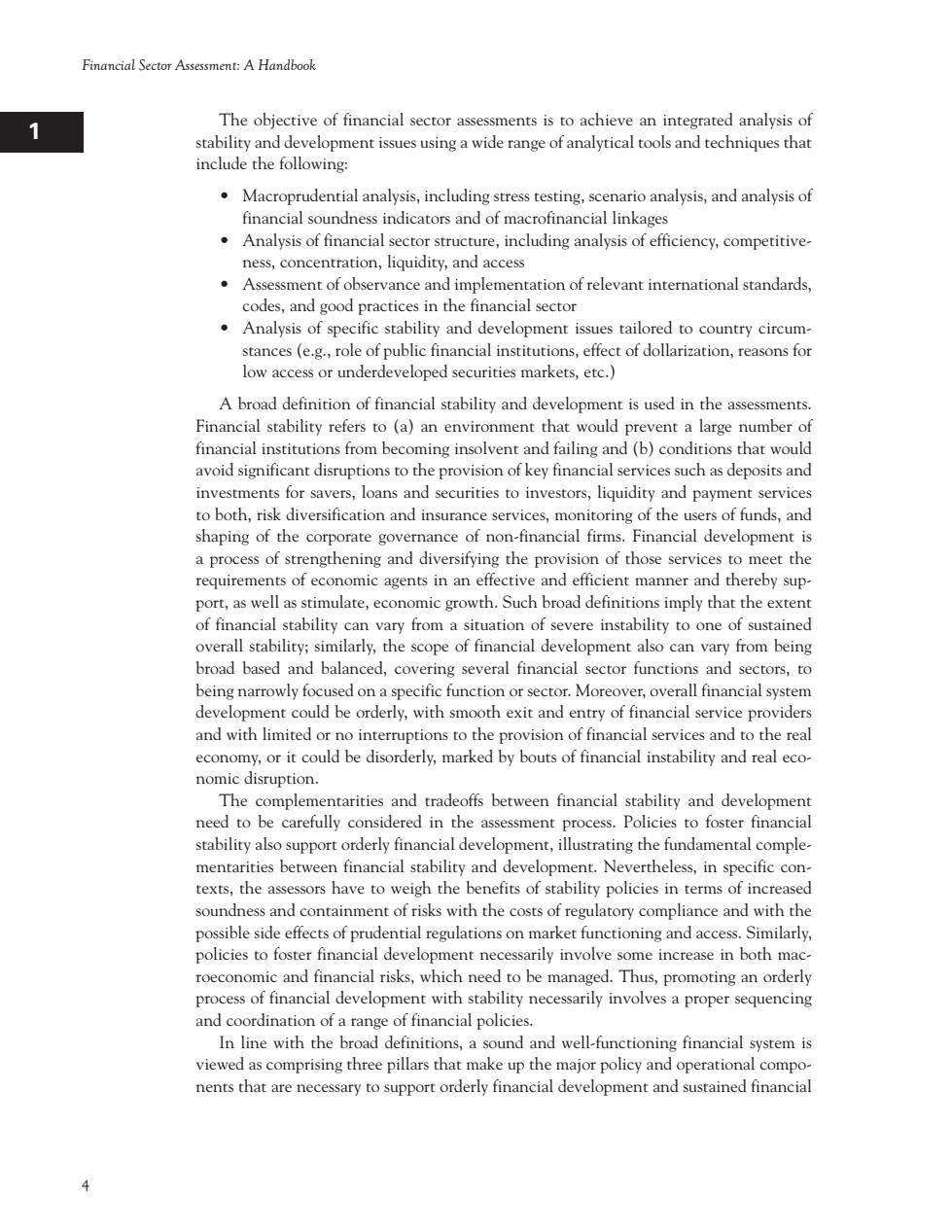正在加载图片...

Financial Sector Assessment:A Handbook The objective of financial sector asse ments is to achieve an integrated analysis of ility and development issues using a wide range of analytical tools and techniques that include the following: .Macroprudential analysis,including stress testing,scenario analysis,and analysis of financial soundness indicators and of macrofinancial linkages .Analysis of financial sector structure,including analysis of efficiency,competitive- ness.concentration.liquidity.and access ment of obse codes.and good pra ce and implementation of relevant international standards, actices in the fin cial sector Analysis ot spe elopment iss stances (e.g.,rol of public financial institut low access or underdeveloped securities markets,etc.) A broad definition of financial stability and development is used in the assessments Financial stability refers to (a)an environment that would prevent a large number of financial institutions from becoming insolvent and failing and(b)conditions that would avoid significant disruptions to the provision of key financial services such as deposits and investments for savers.loans and securities to investors.liguidity and pavment service to both,risk diversification and in ranc services,m ng of the s of funds,and shaping of the 。E ancial eveopmer a process of strengthening and diversifying the pro tho servic requireme omic agents i an d the eby sup port,as well as stimulate,economic growth.Such broad definitions imply that the extent of financial stability can vary from a situation of severe instability to one of sustained overall stability:similarly,the scope of financial development also can vary from being broad based and balanced,covering several financial sector functions and sectors,to being narrowly focused on a specific function or sector.Moreover,overall financial system development could be orderly,with smooth exit and entry of financial service provider and with limited ornoi ons to the vision of fir ial so ices and to the rea economy,or it could be e dis orderly,marked by bouts anc ial instability and I real ecc nom The compleme and offs between financial stability and developmer need to be carefully considered in the assessment process.Policies to foster financia stability also support orderly financial development,illustrating the fundamental comple mentarities between financial stability and development.Nevertheless,in specific con texts,the assessors have to weigh the benefits of stability policies in terms of increased soundness and containment of risks with the costs of regulatory compliance and with the s.Similarly possible side effects of prudential reulaionson market functioning and access. ial develd arily increase in both and f risks, ne ed to be manag ed.Th s,promo ing an orde process of financi development with lity necessarily involves a proper sequencing and coordination of a range of financial policies. In line with the broad definitions,a sound and well-functioning financial system is viewed as comprising three pillars that make up the major policy and operational compo nents that are necessary to support orderly financial development and sustained financial4 Financial Sector Assessment: A Handbook 1 I H G F E D C B A 12 11 10 9 8 7 6 5 4 3 2 The objective of financial sector assessments is to achieve an integrated analysis of stability and development issues using a wide range of analytical tools and techniques that include the following: • Macroprudential analysis, including stress testing, scenario analysis, and analysis of financial soundness indicators and of macrofinancial linkages • Analysis of financial sector structure, including analysis of efficiency, competitiveness, concentration, liquidity, and access • Assessment of observance and implementation of relevant international standards, codes, and good practices in the financial sector • Analysis of specific stability and development issues tailored to country circumstances (e.g., role of public financial institutions, effect of dollarization, reasons for low access or underdeveloped securities markets, etc.) A broad definition of financial stability and development is used in the assessments. Financial stability refers to (a) an environment that would prevent a large number of financial institutions from becoming insolvent and failing and (b) conditions that would avoid significant disruptions to the provision of key financial services such as deposits and investments for savers, loans and securities to investors, liquidity and payment services to both, risk diversification and insurance services, monitoring of the users of funds, and shaping of the corporate governance of non-financial firms. Financial development is a process of strengthening and diversifying the provision of those services to meet the requirements of economic agents in an effective and efficient manner and thereby support, as well as stimulate, economic growth. Such broad definitions imply that the extent of financial stability can vary from a situation of severe instability to one of sustained overall stability; similarly, the scope of financial development also can vary from being broad based and balanced, covering several financial sector functions and sectors, to being narrowly focused on a specific function or sector. Moreover, overall financial system development could be orderly, with smooth exit and entry of financial service providers and with limited or no interruptions to the provision of financial services and to the real economy, or it could be disorderly, marked by bouts of financial instability and real economic disruption. The complementarities and tradeoffs between financial stability and development need to be carefully considered in the assessment process. Policies to foster financial stability also support orderly financial development, illustrating the fundamental complementarities between financial stability and development. Nevertheless, in specific contexts, the assessors have to weigh the benefits of stability policies in terms of increased soundness and containment of risks with the costs of regulatory compliance and with the possible side effects of prudential regulations on market functioning and access. Similarly, policies to foster financial development necessarily involve some increase in both macroeconomic and financial risks, which need to be managed. Thus, promoting an orderly process of financial development with stability necessarily involves a proper sequencing and coordination of a range of financial policies. In line with the broad definitions, a sound and well-functioning financial system is viewed as comprising three pillars that make up the major policy and operational components that are necessary to support orderly financial development and sustained financial